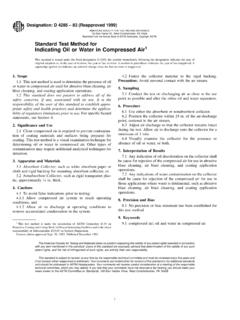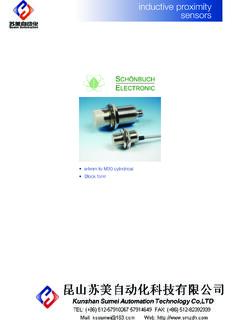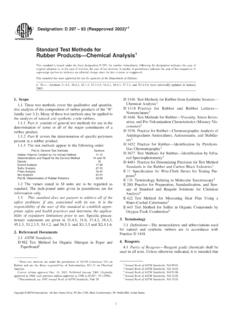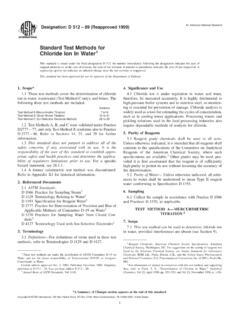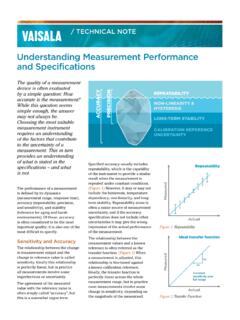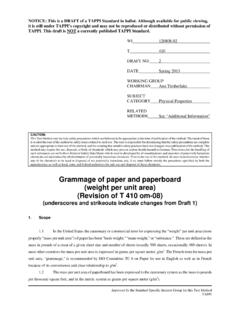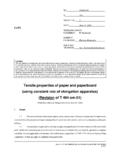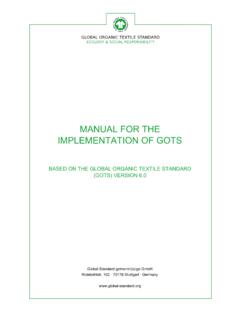Transcription of Standard Test Method for Drop Test of Loaded Containers …
1 Designation: D 5276 98 (Reapproved 2004) Standard Test Method forDrop Test of Loaded Containers by Free Fall1 This Standard is issued under the fixed designation D 5276; the number immediately following the designation indicates the year oforiginal adoption or, in the case of revision, the year of last revision. A number in parentheses indicates the year of last reapproval. Asuperscript epsilon (e) indicates an editorial change since the last revision or This test Method covers procedures for the drop testingof Loaded boxes, cylindrical Containers , and bags and sacks bythe free-fall For Containers not exceeding 110 lb (50 kg), this testmethod fulfills the requirements of ISO standards 2206:1987and 2248 These ISO standards may describeprocedures that do not meet the requirements for this The values stated in inch-pound units are to be regardedas the Standard .
2 The values given in parentheses are forinformation Standard does not purport to address all of thesafety concerns, if any, associated with its use. It is theresponsibility of the user of this Standard to establish appro-priate safety and health practices and determine the applica-bility of regulatory limitations prior to Referenced standards :2D 585 Practice for Sampling and Accepting a Single Lot ofPaper, Paperboard, Fiberboard, and Related ProductD 644 Test Method for Moisture Content of Paper andPaperboard by Oven DryingD 880 Test Method for Impact Testing for Shipping Con-tainers and SystemsD 996 Terminology of Packaging and Distribution Environ-mentsD 2463 Test Method for drop Impact Resistance of Blow-Molded Thermoplastic ContainersD 4003 Test methods for Programmable Horizontal ImpactTest for Shipping Containers and SystemsD 4169 Practice for Performance Testing of Shipping Con-tainers and SystemsD 4332 Practice for conditioning Containers , Packages.
3 OrPackaging Components for TestingD 6055 Test methods for Mechanical Handling of UnitizedLoads and Large Shipping Cases and CratesD 6179 Test methods for Rough Handling of UnitizedLoads and Large Shipping Cases and CratesE 122 Practice for Choice of Sample Size to Estimate aMeasure of Quality for a Lot or ProcessE 680 Test Method for drop Weight Impact Sensitivity ofSolid-Phase Hazardous standards :ISO 2206 Packaging Complete Filled Transport Packages,Identification of Parts When Testing3 ISO 2248 Packaging Complete Filled Transport Packages,Vertical Impact Test by of Federal Regulations:Title 49 Transportation (49 CFR)43. General terms for packaging and distribu-tion environments are found in Terminology D of Terms Specific to This for the purposes of this test Method , acylinder includes substantially cylindrical Containers such asbarrels, drums, kegs, and pails (fiber, metal, plastic, or wood, orcombinations thereof).
4 A face, corner, or edge of a rectangularcontainer; a chime, end, or sidewall of a cylindrical container ;or a face, edge, corner, or butt of a bag or Significance and This test Method is intended for use in evaluating thecapability of a container to withstand the sudden shockresulting from a free fall, or to evaluate the capability of acontainer and its inner packing to protect its contents during thesudden shock resulting from a free fall. This test Method mayalso be used to compare the performance of different packagedesigns. This test Method may also permit observation of theprogressive failure of a container and the damage to test Method is under the jurisdiction of ASTM Committee D10 onPackaging and is the direct responsibility of Subcommittee on Handling edition approved April 10, 1998.
5 Published February 1999. Originallypublished as D 5276 92. Last previous edition D 5276 referenced ASTM standards , visit the ASTM website, , orcontact ASTM Customer Service at ForAnnual Book of ASTMS tandardsvolume information, refer to the Standard s Document Summary page onthe ASTM from the American National standards Institute, 11 W. 42nd St., 13thFloor., New York, NY from the Superintendent of Documents, Government PrintingOffice, Washington, DC ASTM International, 100 Barr Harbor Drive, PO Box C700, West Conshohocken, PA 19428-2959, United This test Method is particularly suitable for containersthat are normally handled manually during some part of theirdistribution cycle. Containers of such bulk or mass that theycannot be handled manually may be tested more satisfactorilyin accordance with Test Method D 880, Test methods D 6055,Test methods D 6179, or Test methods D 4003.
6 See PracticeD 4169 for additional drop Test Equipment, conforming to thefollowing It shall permit the container to be placed, prior torelease, in a position that will ensure correct orientation, within2 degrees upon impact, for flat-face drops or flat drops on endsor sidewalls of cylindrical Containers , and within 5 uponimpact for other drops, such as edge drops and corner drops forrectangular Containers , bags, and sacks and diagonal drops onchimes on cylindrical It shall permit accurate control of the drop fromspecified It shall utilize lifting devices that will not damage thetest It shall provide a release mechanism that does notimpart vertical, rotational, or sideways forces to the testcontainer. If drop leaves are used, the apparatus shall providea spring or other mechanism so that the leaves do not interferewith a free, unobstructed It shall provide an impact surface, horizontal and flat,massive enough to be immovable and rigid enough to benondeformable under the test The impact surface shall be of concrete, stone, orsteel.
7 If the dropping surface is a steel plate, it must be at least1 2in. (13 mm) thick and must be anchored firmly to the Grout (a thin mortar used to fill crevices) is recommendedover the entire surface of the mass below the plate to ensure The impact surface shall be integral with a mass atleast 50 times that of the heaviest container to be the depth nor width of the mass shall be less than halfthe For drop testing of Containers not exceeding 110 lb(50 kg), the impact surface shall be flat, such that no two pointson the surface differ in level by more than5 64in. (2 mm). The impact surface shall be rigid, such that it willnot be deformed by more than in. ( mm) when anarea of (100 mm2) is Loaded statically with lb(10 kg) anywhere on the The impact surface shall be sufficiently large toensure that the Containers being tested fall entirely upon A rupture hazard may be used for determining therupture resistance of cylindrical Containers or bags.
8 Unlessotherwise specified, the rupture hazard should consist ofa4by4-in. (102 by 102-mm) timber, of oak or other wood ofequivalent hardness, approximately 4 ft ( m) long, havingthe edges rounded to a radius of not more than1 4in. ( ). For testing of 49 CFR DOT 21C fiber drums, a 2by 6-in. (51 by 152-mm) timber, with a 6-in. (152-mm) verticaldimension, shall be used. The drum shall be dropped at rightangles to the timber. The drop height shall be measured fromthe top of the For very large Containers , it may be necessary to use ahoist, sling, and tripping devices, or a solenoid-operated droptest mechanism and suspension devices, such as those de-scribed in Appendix Apparatus Adequate facilities shall beprovided for conditioning test specimens at the proper humid-ity and temperature prior to testing, in accordance with thespecification covering the Containers to be Depending on the purpose of thetests, Containers may be conditioned prior to the drop test byeither a different physical test, water immersion, exposure towater spray, or exposure to Standard or other fixed air tempera-ture or humidity conditions.
9 It is recommended that specialatmospheres for conditioning be selected from those given inPractice D 4332. Unless otherwise specified, fiber-board orpaperboard Containers shall be conditioned in accordance withthe preconditioning and Standard conditioning atmospheresspecified in Practice D 4332 (see also Practice D 4169 foradditional guidance). Where the moisture content of fiberboard containersis determined, it should be determined in accordance with TestMethod D The test specimens and number of samples shall bechosen to permit an adequate determination of representativeperformance. Practice E 122 is recommended. Unless other-wise specified, Practice D 585 shall be used for acceptancetesting of fiberboard In the absence of any sampling plan, at least threerepresentative specimens should be selected for Test When the protective capability of a container is to beevaluated, it is preferable to pack the container with the actualcontents for which it was designed (Note 2).
10 When thecapability of a container to withstand rough handling is to beevaluated, pack the container with either the actual contents ora load simulating the contents. Regardless of which procedureis used, close the container in the same manner that will beused in preparing it for Where the use of actual contents is not feasible because ofexcessive cost or danger, a dummy load simulating the contents withrespect to dimensions, center of gravity, moment of inertia, density, flowcharacteristics, etc. may be used. Accelerometers or other indicatingmechanisms may be Close and seal the container in the normal manner. Dryand age sufficiently so that any adhesive, protective coatings,sealing tape, and so forth will have reached their final 5276 98 (2004)2--````,``,,`,``,,,```,,,,`,``,,-` -`,,`,,`,`,,`---8.
